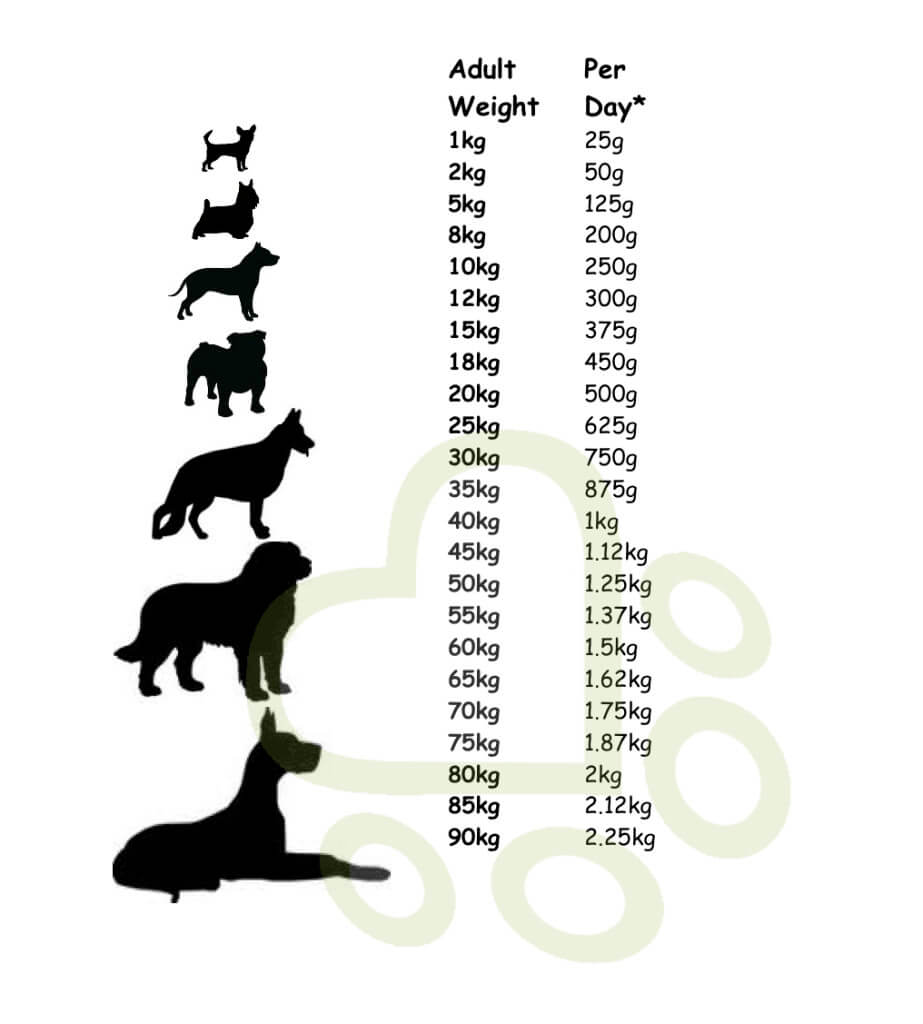
Feeding your dog the correct amount is crucial for your dogs health and performance. Not feeding enough will mean your dog lacks energy and focus which can also cause behavioural issues. Feeding too much can create a slow, lethargic dog that becomes overweight or obese.

Unfortunately there’s no magic answer on exactly how much to feed as every dog is an individual. However, in todays blog post we will review how to find the correct quantity so you can feed your dog just the right amount of food.
When it comes to dog food, we recommend raw as research shows this is by far the most biologically appropriate food for a dog. An adult dog on an “average-calorie”, fresh meat diet will generally eat between 2-3% of their body weight per day. If you’re unsure of how much to feed, your best best is to start feeding 2.5% and monitor your dog using our Body Weight Assessment. That way you can adjust the numbers as you see fit.
For example, a 35KG American Bully, might require 875g of food per day (1% of 35kg is 350g multiplied by 2.5).

Different Types Of Dogs…
Every dog is an individual so you must monitor your dog. If your dog is currently on the heavy side or is recovering from an operation, you can either feed them less or choose leaner meal options. If your dog is super active then feed a little more, but also increase the calorie content of the meal by including fattier cuts, (dogs burn fat for energy). Working dogs can eat 8-10% of their body weight per day, depending on what you have them doing!

There is also a huge difference when it comes to pups. The general rule of thumb is that an eight-week-old pup will be eating up to 10% of their body weight per day of a suitable puppy formula / mix (a pup’s food differs slightly to an adult’s in that they need more fat). By the time they reach 50% of their adult body weight, they will be down to eating 5% of their body weight. By the time they reach full body size they will be down to 3% of their body weight per day, dropping to 2.5% and possibly lower as they enter adult hood.
Want To Get More Accurate?!
The percentages mentioned in this article are general guides. However, the exact results depend greatly on the type of food you are feeding. Obviously a lean mix offers less calories per kilo than a higher fat mix. For this reason, when assessing what a particular dogs energy needs it is better to talk on a calorie or ME (kcal/kg) basis, where ME stands for Metabolisable Energy. This is more detail than most need but if your into working dogs then the details are crucial. The formula for your dog’s Resting Energy Requirement (RER) is 70 x (your dog’s body weight in kg) ^ 0.75
That little hat sign you see there is called a power sign. In English, you would say “70 times your dog’s body weight to the power of 0.75”. You might need a scientific calculator. Find below images of what that button will look like.


Once you have worked out your dog’s RER you can use the following multipliers depending on his physiological state (but know that two dogs of the same sex from the same litter with the same lifestyle can still differ in their ME requirements by up to 20%):
- 1.6 Average neutered adult
- 1.8 Average intact adult
- 1.2 Weight loss
- 2 Light work
- 3 Moderate work
- 5-6 Heavy work
- 3 Growth (<4 months old)
- 2 Growth (>4 months old)

If you need a more personalised approach when it comes to your dogs conditioning you must check out our Conditioning Programs
Keep Them FIT!
FITDOG NATION
P.S.
Check out our top 3 most popular conditioning tools right now